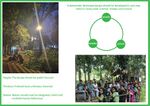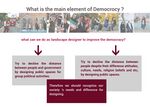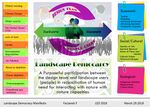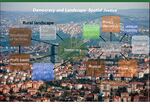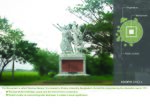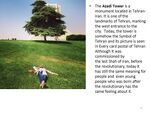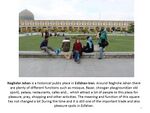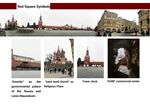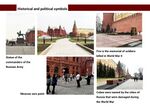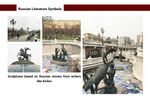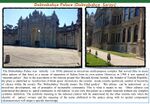LED Online Seminar 2018 - Working Group 5
--> Back to working group overview
Dear working group members. This is your group page and you will be completing the template gradually as we move through the seminar. Good luck and enjoy your collaboration!
Assignment 1 - Reading and Synthesizing Core Terminology
- You can read more details about this assignment here
- Readings are accessible via the resources page
Step 1: Your Landscape Democracy Manifestoes
Step 2: Define your readings
- Please add your readings selection for the terminology exercise before April 18:
A: Landscape and Democracy
Lynch, Kevin. (1960): The Image of the City, Cambridge, Mass.: MIT Press
Sieverts, Thomas (2003): Cities without cities. An interpretation of the Zwischenstadt. English language ed. London: Spon Press.
B: Concepts of Participation
Davis, Mike (1990): Fortress Los Angeles: The Militarization of Urban Space, From: City of Quartz: Excavating the Future in Los Angeles
David, Harvey (2003): The Right to the City, International Journal of Urban and Regional Research, Volume 27, Issue 4, pages 939–941
C: Community and Identity
Woodend, Lorayne (2013): A Study into the Practice of Machizukuri, RTPI
URBACT programme, The European Territorial Cooperation programme aiming to foster sustainable integrated urban development across Europe
D: Designing
Massachusetts Institute of Technology (2013): Places in the Making: How Placemaking Builds Places and Communities
Wates, Nick: The Community Planning Handbook: How people can shape their cities, towns & villages in any part of the world (2nd ed 2014, Routledge)
E: Communicating a Vision
Potteiger, Matthew, and Jamie Purinton. 1998. Landscape narratives: design practices for telling stories. New York: J. Wiley. GoogleBook
Lejano, Raul P., Mrill Ingram, and Helen M. Ingram. 2013. The power of narrative in environmental networks. Cambridge, MA: The MIT Press.
Steps 3 and 4: Concepts Selection and definition
- Each group member selects three relevant concepts derived from his/her readings and synthesize them/publish them on the wiki by May 9, 2018
- Group members reflect within their groups and define their chosen concepts into a shared definition to be posted on the wiki by June 6, 2018.
- Other group members will be able to comment on the definitions until June 12, 2018
- Each group will also report on their process to come to a set of shared definitions of key landscape democracy concepts on the wiki documentation until June 20, 2018
Concepts and definitions
Author 1: ...
- ......
- .......
- .......
Author 2: ...
- ......
- .......
- .......
Author 3: ...
- ......
- .......
- .......
Author 4: ...
- ......
- .......
- .......
Author 5: Oleksandr Galychyn
- Imaginable landscapes are the path dependent single or multiple symbolic orderings (common assemblage networks) within specific community that pass to the the next generation as generalized knowledge through human or (non-human) mediator to foster a sense of community among the individuals.
- The debates the regarding the Right to the City open of question for the establishment of the new urban actor-civic society as a mediator in the participatory governance model to open a road towards an 'inclusive city'. An application of such actor to the urban planning process creates an opportunity for the realization of the spatially just society; therefore, the spatially just community is a community that both employs a participatory governance model at the local level and surpasses formal/informal functional restrictions towards the mutual partnership of during the neighborhoods lifecycle
- The 町造り(Machizukuri) can be perceived as the process of 'space making' that involve the local (urban) participatory network of residents and non-profit organization (research institutes, universities) organized for the entire urban lifecycle in accordance with the principles of innovation, knowledge and learning . The community involvement in the fusion of planning and design placed in the center of aspect the central role since design absent in the USA communities. Japanese perceive the community design process as the management and maintenance of infrastructural networks between buildings and the urban space during the entire lifecycle to preserve their imaginable landscapes as a collective identity for the future generations.
Step 5: Reflection
Step 6: Revised manifestoes
- please look again at your initial manifestoes and update them with any new aspects/prespectives you have taken up during this seminar
Assignment 2 - Your Landscape Symbols
- You can read more details about this assignment here
Landscape Symbols Author 1: ...
- Symbol yourname photovoice3
add a caption (one paragraph max) description of the symbolism, interpretation, as well as geo-location
Landscape Symbols Author 2: ...
- Symbol yourname photovoice3
add a caption (one paragraph max) description of the symbolism, interpretation, as well as geo-location
Landscape Symbols Auther 3: ...
Landscape Symbols Author 4: ...
- Symbol yourname photovoice1
add a caption (one paragraph max) description of the symbolism, interpretation, as well as geo-location
- Symbol yourname photovoice2
add a caption (one paragraph max) description of the symbolism, interpretation, as well as geo-location
- Symbol yourname photovoice3
add a caption (one paragraph max) description of the symbolism, interpretation, as well as geo-location
Landscape Symbols Author 5: ...
MSFAU was initially founded as the archeological museum to retain archeological finds of national enterprises in Ottoman Empire. At present this building is a symbol of equality for all in terms of art and architecture education (social) as well as the nostalgia that takes back to the Ottoman times palaces (historical), and rises a sense of national identity among the visitors of Istanbul (political).
The significance of Basilica Cistern, a one of symbols of Istanbul, at present reaches even a supranational scale. Currently, the local population views it as a symbol of technological dominance and centralized power (owing water means owing the gold) of ‘their own past’ (historical), protection from evil spirits (religious) and unequal access to the resources (social).To me it means ‘ the passage between our world and the underworld (realm of Hades)’.
The Dolmabahçe Palace was initially ( in 1856) planned as mixed-use multi-purpose complex that served as a means of separation of Sultan from its own nation. The ‘Dolmabahçe’ literally means ‘the filled garden’. This phrase can be understood as a mixed-use development, one of principles of sustainable community. Other cultures can understood this phrase as ‘gated community in old fashion’ or just view this palace as a simple museum without any complex symbolic definition.
Assignment 3 - Role Play on Landscape Democracy "movers and shakers"
- You can read more details about this assignment here
Assignment 4 - Your Landscape Democracy Challenge
- You can read more details about this assignment here
- Each group member will specify a landscape democracy challenge in his/her environment
Landscape Democracy Challenge 1
- Give a title to your challenge
- Yourname challenge 1.jpg
caption: why did you select this case?
- Yourname challenge 2.jpg
caption: what is the issue/conflict (1)
- Yourname challenge 3.jpg
caption: what is the issue/conflict (2)
- Yourname challenge 4.jpg
caption: who are the actors?
Your references:
- ...
- ...
Landscape Democracy Challenge 2
- Give a title to your challenge
- Yourname challenge 1.jpg
caption: why did you select this case?
- Yourname challenge 2.jpg
caption: what is the issue/conflict (1)
- Yourname challenge 3.jpg
caption: what is the issue/conflict (2)
- Yourname challenge 4.jpg
caption: who are the actors?
Your references:
- ...
- ...
Landscape Democracy Challenge 3
- Give a title to your challenge
- Yourname challenge 1.jpg
caption: why did you select this case?
- Yourname challenge 2.jpg
caption: what is the issue/conflict (1)
- Yourname challenge 3.jpg
caption: what is the issue/conflict (2)
- Yourname challenge 4.jpg
caption: who are the actors?
Your references:
- ...
- ...
Landscape Democracy Challenge 4
- Give a title to your challenge
- Yourname challenge 1.jpg
caption: why did you select this case?
- Yourname challenge 2.jpg
caption: what is the issue/conflict (1)
- Yourname challenge 3.jpg
caption: what is the issue/conflict (2)
- Yourname challenge 4.jpg
caption: who are the actors?
Your references:
- ...
- ...
Landscape Democracy Challenge 5
- Give a title to your challenge
- Yourname challenge 1.jpg
caption: why did you select this case?
- Yourname challenge 2.jpg
caption: what is the issue/conflict (1)
- Yourname challenge 3.jpg
caption: what is the issue/conflict (2)
- Yourname challenge 4.jpg
caption: who are the actors?
Your references:
- ...
- ...
Assignment 5 - Your Democratic Change Process
- You can read more details about this assignment here
- After documenting and reflecting on your challenges you will continue jointly with one of these challenges and design a democratic change process
Your Democratic Change Process
- Add Title
- Your Democratic Change Process Slide1.jpg
caption: ...
- Your Democratic Change Process Slide2.jpg
caption: ...
- Your Democratic Change Process Slide3.jpg
caption: ...
- Your Democratic Change Process Slide4.jpg
caption: ...
Reflection
- ....
- ....
- ....
Conclusion:
- ....
- ....
- ....
Your references
- ...
- ...
- ...
